Chapter 4.
ST.ANDREW THE FIRST CALLED, WHO BAPTISED RUSSIA IS ANOTHER REFLECTION OF JESUS CHRIST WHO PREACHED IN THE XII CENTURY, AND LIVED AND RULED IN RUSSIA FOR THE MOST PART OF HIS LIFE.
5. THE PARALLELS BETWEEN ST ANDREW AND JESUS CHRIST.
5.1. THE BAPTISM OF CHRIST BY JOHN THE BAPTIST ABD BAPTISM BY ST ANDREW BY JOHN THE BAPTISM.
According to the Gospels Christ having heard of John the Baptist’s preaching came to him and was baptised in the Jordan. ‘And so John the Baptist appeared in the wilderness, preaching a baptism of repentance for the forgiveness of sins… Confessing their sins, they were baptized by him in the Jordan River… At that time Jesus came from Nazareth in Galilee and was baptized by John in the Jordan’ (Marc 1:4-9).
Literally the same thing is said about Andrew the First Called in his Life. We quote: ‘When he heard the preaching of John the Baptist in the Jordan about baptism and repentance he left everything and went to him and became his follower’ [54]. We should note the Gospels do not say anything about Apostle Andrew receiving baptism from John the Baptism. As we understand it now in reality they speak of it when describing the baptism of Christ. In general, all of the Life of Andrew the First Called, as we will see further, acutely reminds us of the Life of Christ. One gets the impression that before us is just two slightly different versions of the same biography.
5.2. THE VIRGINITY OF ANDREW AND THE VIRGINITY OF CHRIST.
According to the Gospels Christ was a virgin, he was never married. In regards to the Apostles of Christ, many of them were married. Nevertheless Andrew the First Called was not married: ‘St. Andrew did not wish to marry and remained a virgin until his death’ [54].
5.3. CHRIST, AS WELL AS ANDREW THE FIRST CALLED, ESTABLISHED A CHURCH IN JERUSALEM = CZAR-GRAD.
It appears that some testimonies survive about ‘the Czar-Grad Church being found by Apostle Andrew, from which the continuous list of its bishops originates, and as a proof of it there was presented the original certificate by St.Dorotheus concerning this subject matter’ [89], book 1, p.265. It is said in the Life of Andrew: ‘St.Andrew … has arrived at Byzantium. Here he was first to preach Christ … he appointed many priests in this country [54].
From the point of view of the new chronology everything here is correct. It is true that Jesus Christ, aka St.Andrew lived for some time in Czar-Grad = Jerusalem, and most likely established a church and a diocese there. No wonder the various old authors report that ‘Apostle Andrew installed the FIRST BISHOP – Stachys, which is clearly reported in the Roman Menaion Reader (Martirologio) (31 Oct.)’ [89], book 1, p.265.
Thus the later Greeks insisted on the apostolic origin of the Constantinople Church, and the Russians – on the apostolic origin of the Russian Church. As we understand it now BOTH WERE RIGHT. But with one nuance: both Constantinople Church and the Russian Church were found most likely by Jesus Christ himself, i.e. Andrew the First Called – Andronicus Comnenus, in the XII century. The later historians missing the point sceptically wrote, in particular, the following: ‘The meaning of the Greek versions of ‘The Travels’ (of the St.Andrew – Author) is for the Empire, as it is well known, in the quasi-canonical substantiation of the claims of Constantinople on the Ecumenical Patriarchate’ [89], book 1, p.38.
Needless to say the ancient ‘Travels’ are perceived by some historians negatively. We quote: ‘Many Roman authors consider this writing by Dorotheus forged pre-eminently because it speaks of the foundation of the Byzantium Church by Holy Apostle Andrew’ [89], book 1, p.265. Some began to say ‘that allegedly this idea WAS INVENTED BY THE GREEKS in order to give importance to the Constantinople throne during their dispute with the high priest of the West’, book 1, p.265. Such a deprecating view of the Scaligerian authors dates most likely from the epoch following the XVII century.
5.4. PASSION AND CRUCIFIXION
5.4.1. THE CITY OF THE FATHERS.
The Passion and crucifixion of Andrew the First Called described in his Life resemble The Passion of Christ. While it does not prove anything per se, such a detail adds well to the parallels we discovered between Andrew and Christ. We will stress that we obtained it from the independent purely chronological reasons. Only later looking at their biographies we see a striking similarity.
This is the way the death of Andrew the First Called is described in his Life. After his lengthy journeys across many countries St. Andrew returned to his homeland, as did Andronicus Comnenus. In the Life of St. Andrew his city is called – Patras of Achaea [78]. Incidentally the word PATRAS itself points at the ’city of PATERS (FATHERS)’. One of the suburbs of Czar-Grad was called PETRION, see for example [141], p.221, 248. That is why Czar-Grad could have been called using the word PETRION or PATRAS. We will point out that the word ACHAEA could be a version of the pronunciation of the word HAGIOS, i.e. Holy. Therefore PATRAS OF ACHAEA in the original text possibly meant HOLY FATHERS or the City of Holy Fathers.
Andrew triumphantly enters the city, however after a while a rebellion breaks out, they seize him, torture and crucify him on a cross.
5.4.2 . RESURRECTION OF LAZARUS BY CHRIST AND THE HEALING OF SOSIUS BY ANDREY.
The Life of Andrew says the following: ‘St. Andrew travelled through many countries and …stayed in the Achaean city of Patras in some pious man’s place by the name of Sosius, who he cured of a very bad illness. This miracle impressed the citizens of the city so deeply THAT THEY ALL FOLLOWED CHRIST’ [54].In the Gospels we also see that Christ BEFORE ENTERING JERUSALEM RESURRECTS LAZARUS and that is why many starting believing in him.
This is the exact sequence of events clearly stated both in the Gospel of John and in the book ‘Passion of Christ’ [127]. Earlier in Chapter 2 we have already quoted the book ‘Passion of Christ’ regarding this matter. We will now quote the Gospel of John: ‘And when he thus had spoken, he cried with a loud voice, Lazarus, come forth. And he that was dead came forth, bound hand and foot with grave clothes: and his face was bound about with a napkin. Jesus saith unto them, Loose him, and let him go. Then many of the Jews which came to Mary, and had seen the things which Jesus did, BELIEVED ON HIM... And the Jews' passover was nigh at … Then Jesus six days before the passover came to Bethany, where Lazarus was, which had been dead, whom he raised from the dead… Much people of the Jews therefore knew that he was there: and they came not for Jesus' sake only, but that they might see Lazarus also, whom he had raised from the dead… On the next day much people that were come to the feast, when they heard that Jesus was coming to Jerusalem, Took branches of palm trees, and went forth to meet him, and cried, Hosanna: Blessed is the King of Israel that cometh in the name of the Lord!’ (John 11:43-12:13).
By the way, we shall comment in regards to the name SOSIUS – the man cured by St. Andrew. In Greek the word SOTER (derived from sṓzō, "save" – Tr. note) means ‘saviour’ [142], v.2, p.616. It seems that this name appeared here not accidentally. Most likely in the old text Andrew the First Called himself was called the SAVIOUR. But the more recent editors did not understanding that it concerned Christ the SAVIOUR, changed this word into the name SOSIUS. Thus SOSIUS is most likely the indication of the word SAVIOUR in the Life of Andrew the First Called.
Thus The Lord’s entrance into Jerusalem and ‘Andrew’s entrance into Patras of Achaea’ are described in essence similarly. Both of them begin with some healing which impressed those present so deeply, that they all began to believe.
5.4.3. THE REBELLION IN THE CAPITAL.
In the Life of Andrew it is said: ‘The proconsul Aegeates was furious at seeing such success of Apostle Andrew’s preaching. He ordered to arrest the preacher of the Christian faith and crucify him … AFTER ENTERING THE CITY OF PATRAS the proconsul Aegeates began forcing those who believed in Christ to bring sacrifices to the idols. St. Andrew met him on the road and said … Aegeates asked Andrew: ‘Are you not the same Andrew that ravages the temples and preaches to the people about the recently emerged magical faith, which the Roman emperors ordered to destroy? … Aegeates became enraged with the holy apostle and ordered him cast into prison… Everyone was outraged by Aegeates’ action and wanted to kill him and to free St. Andrew. But the holy apostle stopped them from doing so saying: ‘Do not turn the world of our Lord Jesus Christ into the Devil’s Mutiny!’ [54].
Thus the Life of Andrew, as do the Gospels and Andronicus’ biography describe THE MUTINY AGAINST THE SAINT. The word MUTINY is used here directly. Besides it is said that Aegeates ENTERED the city of Patras in order to capture St. Andrew. This also indirectly points to some military action taking place, a mutiny. Otherwise the proconsul wouldn’t have ‘to enter the city’. He could have been quietly staying in his capital palace. Usually they ‘enter the city’ by force, at the head of the army.
Note also that the charges in RAVAGING THE TEMPLES put forward against Apostle Andrew clearly closely resonate with the Gospels charges by the high priests against Christ. To recall, Christ cast the traders out of the temples, which angered many, see above ch.2. Matthew the Evangelist identifies as the reason for his condemnation his words about him being capable of destroying the God’s Temple and then to build it in three days. ‘Now the chief priests, and elders, and all the council, sought false witness against Jesus, to put him to death; But found none… At the last came two false witnesses, And said, This fellow said, I am able to destroy the temple of God, and to build it in three days’ (Matthew 26:59-61). Here, as in the Life of Andrew the First Called ‘the attempt to destroy the temple’ is put forward as the main accusation.
The name AEHEATES or AGEATES could have occurred due to the incorrect reading of the word CAIAPHAS. The consonant compounds of the words are essentially the same: AGEATES = GT, and CAIAPHAS = KPH. But the sound G often transfers into K, and the sounds T and F (PH) are the two versions of pronouncing the same letter FITA (Ѳ).
Besides, the name AEHEATES is assonant with the word HEGEMON, i.e. with the post of Pontius Pilates. To recall Pilates, as we know, was referred to as hegemon [153]. In the contemporary Russian language this word exists as HEGUMEN, i.e. father superior. It is thought that the Russian word HEGUMEN is borrowed from the Greek HEGEMON. But in fact it was probably the other way round. As the Greek HEGEMON came from most likely a well known Russian word IGO, meaning RULE. Hehe-mon or Igo-mon means ‘rule-man’, i.e. a man in authority.
Then the Life describes a conversation between Aeheates and Andrew, which very much resembles Pilates’ trial of Christ. In both cases an interesting detail is noted: the indirect participation of the wife of the judge (Pilates or Aeheates) in the trial over Andrew-Christ. Pilates’ wife as Aeheates’ wife was against the execution. The Gospel of Matthew says: ‘When he (Pilates – Author) was set down on the judgment seat, his wife sent unto him, saying, Have thou nothing to do with that just man: for I have suffered many things this day in a dream because of him’ (Matthew 27:19). The book ‘Passion of Christ’ informs us on the same matter: ‘To Pilates who was sitting at trial at the time, his wife sent a message saying: do not do any harm to this righteous man, as I have suffered a lot in my dream for him’ [127], list 72. And further: ‘Pilates’ wife did not revere the law (of God – Tr.): neither the Scriptures, nor the Prophet, not knowing the prophecy, but knew the Lord God’ [127], list 72. Thus it is clearly said that Pilates’ wife began to believe in Christ. And even did not sleep all night anxious over his fate.
Also ‘the wife of proconsul Aeheates, after being cured by St. Andrew from her illness … began to believe in Christ’ [54].
5.4.4. THE CRUCIFIXION.
The Life of Andrew the First Called reports: ‘Aeheates ordered to slay the holy man on the ground and for three tormentors to beat him … At last the holy martyr was picked up and brought to the judge … Aeheates was infuriated by the words of the holy man. He ordered to crucify St. Andrew on the cross… When St. Andrew was led to his crucifixion by the tormentors FROM EVERYWHERE FLOCKED TO HIM GREAT MULTITUDE OF PEOPLE … St. Andrew TOOK OFF HIS GARMENTS and gave them to his tormentors. The latter ones having received the garments from the holy martyr LIFTED HIS CROSS and having tied the martyr’s hands and feet to the cross, crucified him and hanged him on it. NEARLY TWENTY THOUSAND PEOPLE GATHERED NEAR THE CROSS.
Such a description is quite close to the Gospels. Christ was also beaten for long time at first, and then he was brought to the crucifixion accompanied by the crowds of people, see fig.4.10  and fig.4.11
and fig.4.11  . There were a lot of people standing around the cross (John 19:20). This is exactly how the scene of crucifixion is depicted on the drawing by A.Durer ‘The Great Calvary’ [38], p.306, illustration 408. We do not present it here as it did not preserve very well and the image faded quite a lot. Instead we will reproduce the work by ‘Velvet’ Jan Brueghel the Elder under the same name, see fig.4.12
. There were a lot of people standing around the cross (John 19:20). This is exactly how the scene of crucifixion is depicted on the drawing by A.Durer ‘The Great Calvary’ [38], p.306, illustration 408. We do not present it here as it did not preserve very well and the image faded quite a lot. Instead we will reproduce the work by ‘Velvet’ Jan Brueghel the Elder under the same name, see fig.4.12 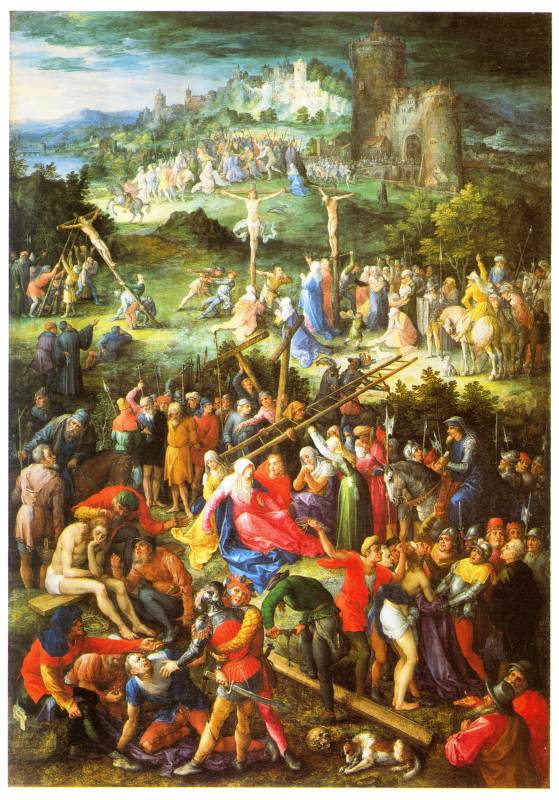 , considered to be the freestyle reproduction of ‘The Great Calvary’ by A.Durer. On the whole there survive a lot of old depictions of the large gatherings of people present at Christ’s crucifixion.
, considered to be the freestyle reproduction of ‘The Great Calvary’ by A.Durer. On the whole there survive a lot of old depictions of the large gatherings of people present at Christ’s crucifixion.
Christ’s garments were taken by those crucifying him: ‘Then the soldiers, when they had crucified Jesus, took his garments, and made four parts, to every soldier a part; and also his coat: now the coat was without seam, woven from the top throughout’ (John 19:23).
5.4.5. DESCENT FROM THE CROSS.
We don’t have to remind you of the well known details of Christ descent from the cross, see above. Let us see what is written in the Life of Andrew the First Called: ‘A certain woman by the name of Maximilla of the senatorial family, having learnt that St. Andrew returned to the Lord, took his body off the cross with great honour and after anointing it with precious oils she put it into her tomb which she had prepared for herself’ [54].
Christ was also taken off the cross, his body was wrapped, with spices, in strips of linen and laid into a new tomb (John 19:38-41). To note that on the icons depicting the Descent of Christ from the cross, they always paint women by the cross, see for example fig.4.13 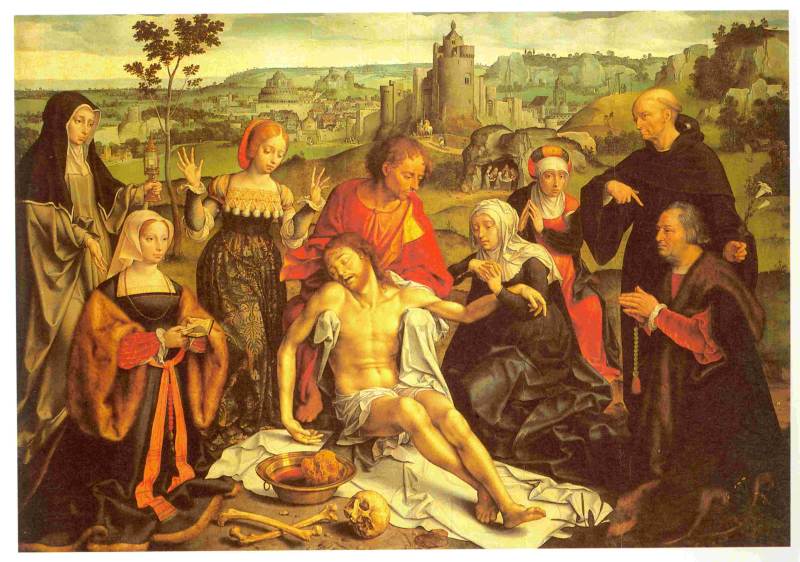 and fig.4.14
and fig.4.14 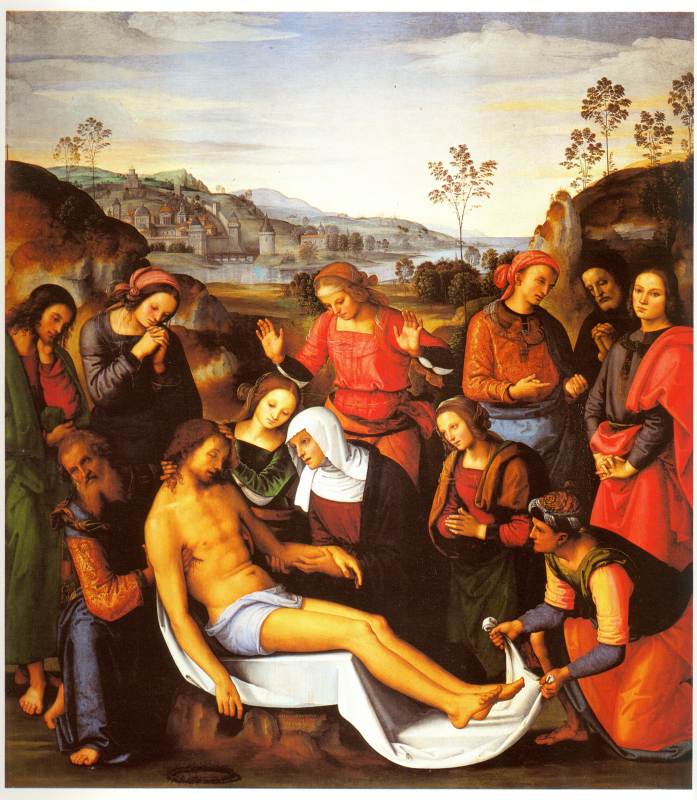 . Fig.4.15
. Fig.4.15 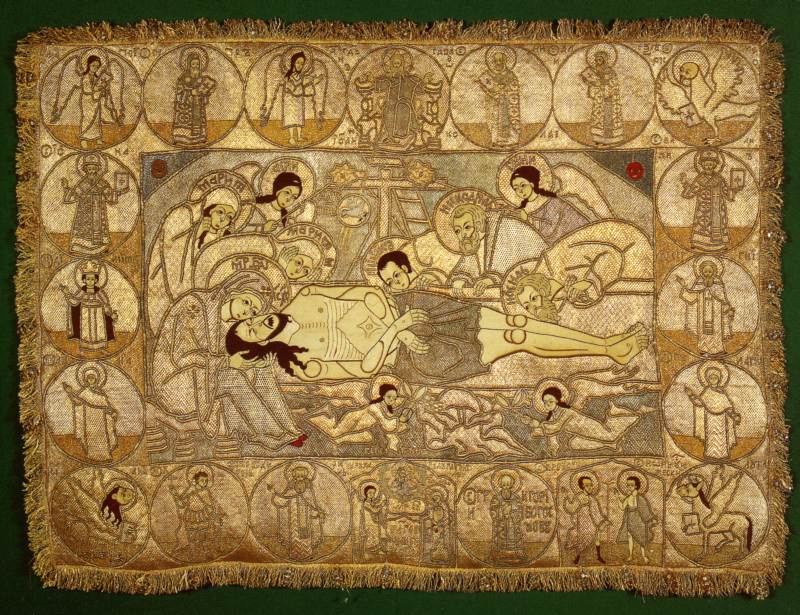 presents an old Russian veil (a shroud to cover vessels) ‘The Entombment’. The image is interesting in particular by the fact that there are the names of the characters written on it in plain text.
presents an old Russian veil (a shroud to cover vessels) ‘The Entombment’. The image is interesting in particular by the fact that there are the names of the characters written on it in plain text.
5.4.6. ASCENSION AND TRANSFIGURATION.
The Gospels ends with Christ ascending to heaven: ’And he led them out as far as to Bethany, and he lifted up his hands, and blessed them. And it came to pass, while he blessed them, he was parted from them, and carried up into heaven. And they worshipped him, and returned to Jerusalem with great joy’ (Luke 24:50-52). This event is commemorated in the Christian Ascension-Day.
Besides, the Gospels describe the Transfiguration: ‘And after six days Jesus taketh Peter, James, and John his brother, and bringeth them up into an high mountain apart, And was transfigured before them: and his face did shine as the sun, and his raiment was white as the light… While he yet spake, behold, a bright cloud overshadowed them: and behold a voice out of the cloud, which said, This is my beloved Son, in whom I am well pleased; hear ye him’ (Matthew 17:1-5). See fig.4.16 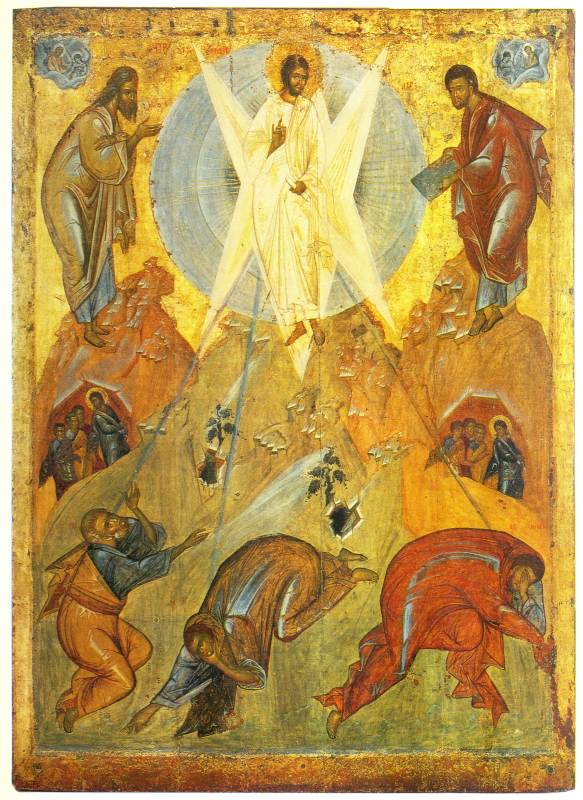 .
.
Something similar is also described in the Life of Andrew the First called: ‘When St. Andrew uttered that prayer, suddenly in front of all the people, like a lightening, there appeared a light and illuminated the holy martyr. This miraculous light shone on the martyr so, that those next to him could not look at him. Nearly half an hour this wonderful light continued to illuminate the martyr; when it disappeared the holy apostle drew his last breath and left with the radiant light in order to stand before the Lord’ [54].
It is likely that in this description the Gospel Ascension and Transfiguration merged together.
5.4.7. JUDAS’ THIRTY PIECES OF SILVER AND HIS DEATH.
The Gospels describe how Judas who betrayed Christ for thirty pieces of silver repented and brought them back to the high priests. But they did not take them as the money was defiled.’ Then Judas, His betrayer, seeing that He had been condemned, was remorseful and brought back the thirty pieces of silver to the chief priests and elders, saying, “I have sinned by betraying innocent blood.” … Then he threw down the pieces of silver in the temple and departed, and went and hanged himself. But the chief priests took the silver pieces and said, “It is not lawful to put them into the treasury, because they are the price of blood.” (Matthew 27:3-6).
In the Life of Andrew the First Called proconsul Aeheates acts in a dual role. On one hand as the Gospel Pilates or Caiaphas who condemned Christ to death. But he also appears in the Life of Andrew as Judas who betrayed Christ. Namely in the Life it is said about a certain Stratocles, a brother of Aeheates: <<Selfless Stratocles refused to receive the inheritance from his brother Aeheates … "in order to not be defiled by its sin">> [54]. It is probably a blueprint of the well known Gospel story about repented Judas wishing to return the thirty pieces of silver to the high priests, but they refused to take them because they were the "price of blood". In the story of Andrew the First Called Aeheates’ brother Stratocles refuses to accept Aeheates’ money "soiled by blood".
5.4.8.’TOUCH ME NOT’.
In the Life of Andrew the First Called there is one rather interesting place. It is said there, that they tried to take Andrew down from the cross, but were not able to touch him. ‘Aeheates’ servants tried to remove the holy apostle from the cross BUT COULD NOT TOUCH HIM. Many among those who were present also tried to free the martyr, but also to no avail: their hands would just freeze.’ [54]. Here one immediately recalls the Gospel of John. ‘But Mary stood without at the sepulchre weeping: and as she wept … she turned herself back, and saw Jesus standing … Jesus saith unto her, Mary. She turned herself, and saith unto him, Rabboni; which is to say, Master. Jesus saith unto her, TOUCH ME NOT; for I am not yet ascended to my Father’ (John 20:11-17).
Fig.4.17  represents one of the multitudes of the old depictions of this well known story.
represents one of the multitudes of the old depictions of this well known story.
There emerges an impression that the above mentioned scene from the Life of Andrew the First Called and the Gospel words ‘Touch Me not’ revert to one and the same original.